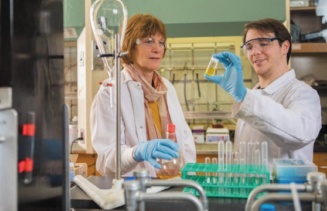Research Highlights: Showcase on Capitol Hill
Company Co-Founded By UB Chemist Selected To Attend Startup Showcase On Capitol Hill
Adapted from UBNow article written by Charlotte Hsu.
Ferric Contrast Inc., a startup with strong ties to UB, was selected to attend the University Innovation and Entrepreneurship Showcase last spring on Capitol Hill in Washington, D.C.
Hosted by the Association of Public and Land-grant Universities (APLU) and the Association of American Universities (AAU), the April 10 event spotlighted 20 startup companies from across the nation that have created products and services using federally funded, university-based research.

Ferric Contrast is developing iron-based contrast agents for magnetic resonance imaging. The focus is on producing a multipurpose agent that can be used to obtain high-quality magnetic resonance images (MRI) of the brain, vasculature and liver, and for detection of cancerous tumors.
Ferric Contrast was launched in 2017 by Prof. Janet Morrow and entrepreneur Bradford La Salle to commercialize research from Morrow’s lab. The company licenses technology from UB and is based at the UB Technology Incubator in Amherst.
Both Morrow and La Salle attend the showcase, which highlighted the important role of federally-funded university research in driving high-value entrepreneurship and the U.S. innovation economy for members of Congress, their staff, and national economic development and innovation policy leaders.
“Innovation taking place in UB labs is helping to drive the formation of new companies in the life sciences and other sectors in the Western New York economy,” said Venu Govindaraju, UB’s vice president for research and economic development.
“Ferric Contrast is leveraging the region’s growing entrepreneurial ecosystem, including resources at UB, to develop a product that aims to improve MRI technology, with the goal of helping patients.”
Partnering With UB to Develop A Sought-After Technology
Ferric Contrast’s technology is timely: The MRI contrast agents that dominate the market today contain gadolinium, and recent studies have found that multiple MRI procedures with gadolinium-based contrast agents can lead to gadolinium accumulation in patients’ brains and other organs, raising safety concerns.
Doctors and oversight agencies are seeking alternatives, and iron-based contrast agents are intriguing candidates. As Morrow explains, iron is natural: It’s found in blood, and the human body has ways of clearing and recycling the element.
“There are opportunities for developing alternatives to gadolinium-based contrast agents, and also for developing iron-based contrast agents with unique properties for new applications,” Morrow said.
To advance its technology, Ferric Contrast is leveraging the entrepreneurial ecosystem that UB and partners are building in Western New York.
Among other support, the university has assisted the company in securing a National Science Foundation (NSF) Small Business Technology Transfer (STTR) award.
UB’s Business and Entrepreneur Partnerships team also facilitated Ferric Contrast’s participation in the NSF I-Corps national program, which prepares scientists to commercialize discoveries, and the Pre-Seed Workshop for entrepreneurs hosted at UB.
The company employs a recent UB chemistry PhD graduate, Patrick Burns, as a fulltime chemist. In addition, the STTR award supports a UB student to help develop new contrast agents. UB has also provided funding to support work in Morrow's UB lab that advances the technology that Ferric Contrast is developing.